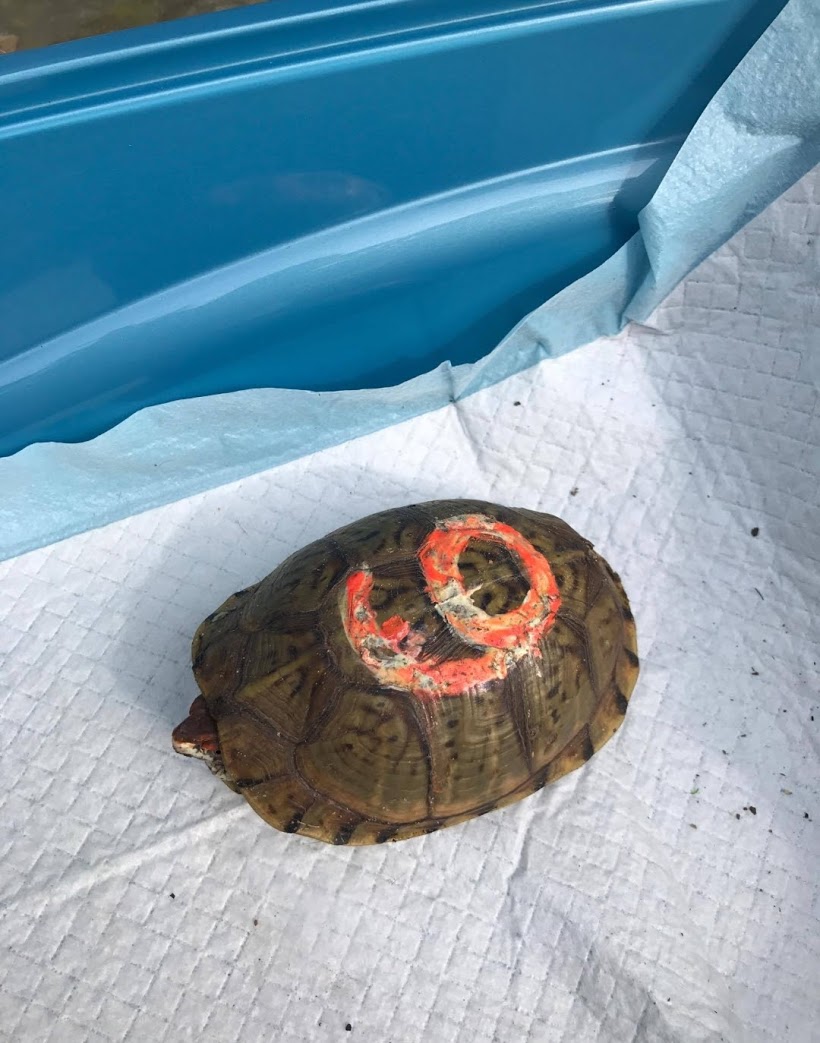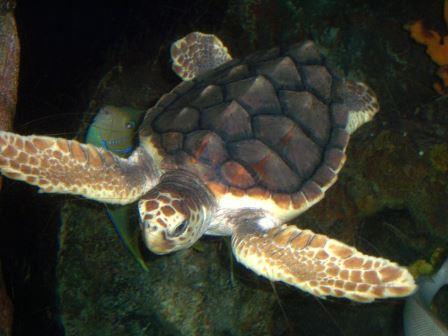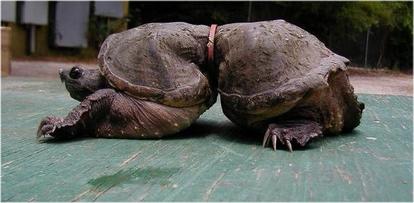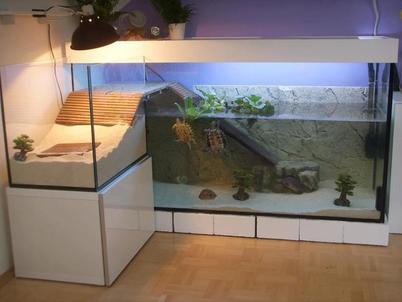Q: Is it called a turtle, a tortoise, or a terrapin?
A: What a turtle is called and what a turtle actually is, are two very different things. Colloquially, the answer varies depending on where you live. Generally in the United States, a TURTLE is a shelled reptile that lives most (or part) of the time in water. A TORTOISE is a shelled reptile that lives exclusively on land and has elephant-like feet. And the term TERRAPIN is usually reserved for one specific species of turtle - the Diamondback Terrapin, a semi-aquatic turtle that lives in brackish waters. Some other countries refer to any turtle in the ocean as turtle, any turtle in freshwater as a terrapin, and any turtle on land as a tortoise. So, these terms can be regionally specific. For the purpose of this answer, and to reduce confusion, we'll stick to turtles of the United States.
Scientifically/taxonomically, ALL shelled reptiles are TURTLES or chelonians - belonging to the Order Testudines (or Chelonii). In other words, if it's a reptile with a shell, it's a TURTLE.
In America, we generally refer to any fully-aquatic shelled reptile as a TURTLE. TORTOISE refers to fully-terrestrial (land-only) turtles, or only those members of the Testudinidae Family. TERRAPIN refers to semi-aquatic turtles that live in brackish water.
Below you'll see some examples of how we classify turtles, tortoises, and terrapins here in Mississippi. (And even here, these terms can be relative based on region. I've heard some folks refer to box turtles as "tomata eatin terrapins".)
A: What a turtle is called and what a turtle actually is, are two very different things. Colloquially, the answer varies depending on where you live. Generally in the United States, a TURTLE is a shelled reptile that lives most (or part) of the time in water. A TORTOISE is a shelled reptile that lives exclusively on land and has elephant-like feet. And the term TERRAPIN is usually reserved for one specific species of turtle - the Diamondback Terrapin, a semi-aquatic turtle that lives in brackish waters. Some other countries refer to any turtle in the ocean as turtle, any turtle in freshwater as a terrapin, and any turtle on land as a tortoise. So, these terms can be regionally specific. For the purpose of this answer, and to reduce confusion, we'll stick to turtles of the United States.
Scientifically/taxonomically, ALL shelled reptiles are TURTLES or chelonians - belonging to the Order Testudines (or Chelonii). In other words, if it's a reptile with a shell, it's a TURTLE.
In America, we generally refer to any fully-aquatic shelled reptile as a TURTLE. TORTOISE refers to fully-terrestrial (land-only) turtles, or only those members of the Testudinidae Family. TERRAPIN refers to semi-aquatic turtles that live in brackish water.
Below you'll see some examples of how we classify turtles, tortoises, and terrapins here in Mississippi. (And even here, these terms can be relative based on region. I've heard some folks refer to box turtles as "tomata eatin terrapins".)
|
TURTLE (Family Emydidae) - These turtles are aquatic and live almost exclusively in water, only coming out at times to bask. The feet are webbed, and the body is streamlined for swimming. They inhabit ponds, lakes, streams, creeks, and even rivers.
|
TURTLE (Family Emydidae) - This is a box turtle, not a box tortoise. While they do spend much of their time on dry land, they also spend quite a bit of time in shallow water and are considered semi-aquatic. Their bodies are round and their feet are not webbed. Their shells are hinged, which allows them to fully seal themselves inside, like a box! They are box turtles, NOT TORTOISES because they do spend much of their time in water and because they belong to the scientific Family Emydidae (not Testudinidae, which is the scientific Family of tortoises.)
|
|
TORTOISE (Family Testudinidae) - This turtle is called a tortoise. The feet are not webbed, and they live almost exclusively on land - only entering shallow water to get a drink now and then. Their legs/feet generally resemble those of an elephant. Many tortoises get quite large and can weigh several hundred pounds.
|
TERRAPIN (Family Emydidae)- This turtle is called a terrapin. They are considered semi-aquatic, with webbed feet and streamlined, swimmers' bodies. They are generally found in brackish water (a mix of fresh and saltwater) where fresh water rivers and saltwater oceans/gulfs meet. These are the only variety of turtle in America called terrapins. (There are some turtles in other cuntries that are also called Terrapin.)
|
Q: How can I tell if a turtle a male or a female?
A: It depends on the type and age of the turtle. Turtles usually don't develop sexually distinctive characteristics until they grow to 4 or 5" long in shell length (called Straight Carapace Length, or SCL). For most turtles, reaching that size takes several years. At birth, most turtles look female until they grow to that 4-5" SCL mark.
In general:
A: It depends on the type and age of the turtle. Turtles usually don't develop sexually distinctive characteristics until they grow to 4 or 5" long in shell length (called Straight Carapace Length, or SCL). For most turtles, reaching that size takes several years. At birth, most turtles look female until they grow to that 4-5" SCL mark.
In general:
- Males of most common Mississippi species stay smaller than females. This isn't always the case though.
- Males are usually more colorful or vibrant.
- The tail of a male is usually longer and thicker at the base than a female, and the cloaca (opening) is usually farther beyond the edge of the shell. A female's cloaca will be closer to the body, and she'll usually have a shorter, stubbier tail.
- Male aquatic turtles, such as sliders, will get very long Freddy Kreuger-looking nails on their front claws.
- Male box turtles will have a slightly concaved (indented) plastron (bottom shell), and their back claws will be hook-shaped.
|
Q: Can I keep a wild turtle as a pet?
A: Please don't. Turtles in the wild should stay in the wild. Many populations of turtles in Mississippi and around the country are in decline, so we should always give them the right to remain free, reproduce, and create more populations of turtles for future generations. Besides, most wild turtles don't do very well in captivity. It's best to just let them be wild. If you're interested in keeping turtles, we'd love to talk to you about adopting one that needs a home, or we can put you in contact with another rescue organization for adoption. However, if you do find yourself with a new turtle, please make sure and do your research. Turtles aren't as easy to keep as most people think. They require so much more than just a tank and some lettuce. Many turtles die slow, painful deaths from improper husbandry. You are always welcome to contact us if you have any questions about the care of a turtle. Also, always check state and federal laws before taking, moving, or even touching a wild turtle. Some species are heavily protected, with punishments that include hefty fines or even jail time. In Mississippi, you must possess a Resident Sportsman's license or Resident All Game Hunting and Freshwater Fishing License, or a Small Game Hunting and Freshwater Fishing License or a Non-Resident All Game Hunting License to possess native turtles, and there are limits on how many you can have and what species you can have. Head over to the Mississippi Department of Wildlife, Fisheries, and Parks for more info. |
Q: Do turtles feel pain, fear, anger, love, stress, or happiness?
A: We'll address each individually ...
A: We'll address each individually ...
- Pain - absolutely. They have pain receptors (called nociceptors), just like we do, that register the sensation of pain. So, when one is injured they feel the pain of it just like we would if we were injured. (They even sense pain on their shells!)
- Fear - it's what keeps them alive! Their fear instinct is fairly advanced. They haven't lived millions of years without knowing when danger is near, fearing it, and knowing when to flee!
- Stress - most definitely. Turtles are easily stressed. This stress response is closely related to fear and can be brought on by change of environment, illness, injury, or incorrect habitat among other things. A turtle's stress level is also closely linked to its immune system. A sick or injured turtle recuperates much faster if his stress levels are kept to a minimum.
- Anger/Happiness - these are hotly debated topics. Most people tend to assign human emotion to animals. This is called Anthropomorphism. In reality, turtles and tortoises do not feel the range of emotions that humans do.
- Anger - Turtles can and do fight with other turtles, not out of animosity, but rather as a means to an end. For instance, they will fight other turtles that are competition for a mate or for food. But, if you forget to feed your turtle one day, will he be angry with you? No - he'll just be hungry.
- Love/Happiness - we all like to think our animals are happy, but they just don't process emotion the way we think they do. The part of their brains that process sensations doesn't function quite the same. A turtle may be content or satisfied, but not happy in the sense of the word that we've come to associate it with. The turtles aren't out there in the ponds throwing a party because the turtle next door got a job promotion. When we here at CMTR use the term "happy" we say it to mean that our turtles' needs are met, and we feel they are content. On the same token, scientists don't believe that turtles feel love in the same way that we do either. It is debated whether or not they feel bonded to other turtles, or even to their long-time human companions. It is generally felt that turtles may become accustomed, and therefore less fearful, of us. But no evidence exists that turtles actually feel "love". When a long-time companion turtle or human is no longer present in the turtle's life, it doesn't feel a loss. It isn't sad. There is no pity party. The turtle will notice a difference, and this difference may be somewhat stressful (since turtles don't really care for change too much), but they don't feel it as sorrow or mourning at losing a loved one the way we would.
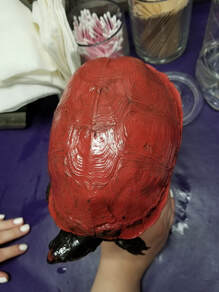
Q: Does it harm a turtle to paint its shell?
A: YES!
A turtle's coloration is designed to give the turtle the best camouflage possible so that he blends in, and predators don't easily see him. How well do you think he'll hide from a hungry predator looking like this?
Additionally, a turtle's shell is a living part of its body. The toxic chemicals used in markers or paint can be absorbed through the shell into the turtle's bloodstream. This can make a turtle sick, or it could even be deadly. Please, never mark on a turtle in any way. Besides, they're beautiful just the way they are. They don't need any extra adornment.
And perhaps most important is that if you paint a turtle, you're covering up much of the surface area of that turtle. Turtles MUST absorb UVB light from the sun which their bodies convert to Vitamin D3. Without Vitamin D3, they cannot absorb calcium, which can lead to soft or brittle bones - a condition called Metabolic Bone Disease, which can be fatal. While much of the UVB rays are absorbed through a turtle's skin, there's not much skin surface area on a box turtle or tortoise that's regularly exposed to sunlight, and it is believed that they likely absorb UVB rays through their shell as well as their skin. Covering the surface of the shell could greatly reduce the amount of UVB the turtle can absorb.
A: YES!
A turtle's coloration is designed to give the turtle the best camouflage possible so that he blends in, and predators don't easily see him. How well do you think he'll hide from a hungry predator looking like this?
Additionally, a turtle's shell is a living part of its body. The toxic chemicals used in markers or paint can be absorbed through the shell into the turtle's bloodstream. This can make a turtle sick, or it could even be deadly. Please, never mark on a turtle in any way. Besides, they're beautiful just the way they are. They don't need any extra adornment.
And perhaps most important is that if you paint a turtle, you're covering up much of the surface area of that turtle. Turtles MUST absorb UVB light from the sun which their bodies convert to Vitamin D3. Without Vitamin D3, they cannot absorb calcium, which can lead to soft or brittle bones - a condition called Metabolic Bone Disease, which can be fatal. While much of the UVB rays are absorbed through a turtle's skin, there's not much skin surface area on a box turtle or tortoise that's regularly exposed to sunlight, and it is believed that they likely absorb UVB rays through their shell as well as their skin. Covering the surface of the shell could greatly reduce the amount of UVB the turtle can absorb.
|
Q: Why are "Turtle Races" a bad thing?
A: There are many reasons.
|
|
Q: Do turtles carry salmonella?
Yes. But so does every other animal. A little common sense is all you need to stay salmonella-free when interacting with turtles. Back in the 60's and 70's, pet baby turtles (usually Red Eared Sliders) could be bought at any five-and-dime store. Kids loved these tiny little turtles, and parents loved their kids having a pet that didn't bark, pee on the carpet, or eat mom's favorite shoes. But, kids are not the best at washing their hands, and they also love to put things in their mouths and kiss their pets. Over time, parents and doctors realized that these children with pet turtles were developing salmonella infections. This led to outrage and new laws - including the famous 4-inch Law which basically states that it is illegal to sell a turtle under 4 inches as a pet. And then the fear mongering began. Even today you can't escape hearing about how "dangerous" turtles are due to their salmonella risk. (The media just loves the word "contaminated". It sounds so scary and makes you want to read their article!) But let's be rational here...ALL animals carry salmonella (among other bacteria). Would you prepare fresh chicken for your family and not wash your hands afterward? Would you pet your dog and then put your hands in your mouth without washing up first? Common sense hand-washing and hygiene are all it takes to prevent contamination. Wash your hands after handling any turtle, don't kiss turtles, and if you have kids, make sure they also wash up and never put a turtle in their mouth. |
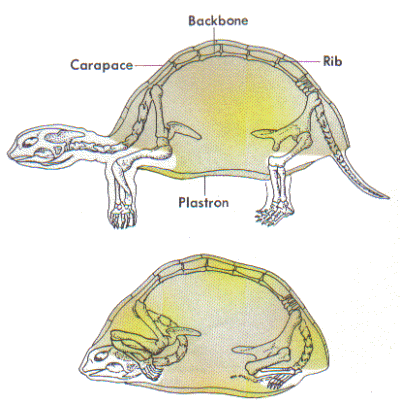 Photo courtesy of Kawartha Turtle Trauma Centre
Photo courtesy of Kawartha Turtle Trauma Centre
Q: Can a turtle come out of his shell?
A: Nope, nope and nope! No matter how many cartoons portray this as possible, the only way in real life you'll see a turtle without a shell is if it's dead. A turtle's shell is really an extension of his rib cage. The bones of his ribs grow around the outside of the organs. These rib bones then fuse together, forming a solid shell that surrounds the turtle. On top of the bone is a thin layer of keratin (much like the keratin on your own fingernails.) The keratin layer is the part we see in pretty camouflage patterns. In the diagram to the right, you can see how the ribs form the shell, and are connected to the head, neck, and tail.
A: Nope, nope and nope! No matter how many cartoons portray this as possible, the only way in real life you'll see a turtle without a shell is if it's dead. A turtle's shell is really an extension of his rib cage. The bones of his ribs grow around the outside of the organs. These rib bones then fuse together, forming a solid shell that surrounds the turtle. On top of the bone is a thin layer of keratin (much like the keratin on your own fingernails.) The keratin layer is the part we see in pretty camouflage patterns. In the diagram to the right, you can see how the ribs form the shell, and are connected to the head, neck, and tail.
 Photo credit: unknown
Photo credit: unknown
Q: Does a turtle have feeling in its shell?
A: Yes a turtle's shell does have feeling!
If you scratch a turtle, he will feel it just as if you were scratching his skin. He can also feel pain through his shell. We've sadly seen many cases where humans have drilled holes in turtles' shells. They do this for many (bad) reasons - to hook a chain to them to tether them to a fence or leash, to carry them, etc. This is EXTREMELY painful for the turtle and should never, ever, be done.
A: Yes a turtle's shell does have feeling!
If you scratch a turtle, he will feel it just as if you were scratching his skin. He can also feel pain through his shell. We've sadly seen many cases where humans have drilled holes in turtles' shells. They do this for many (bad) reasons - to hook a chain to them to tether them to a fence or leash, to carry them, etc. This is EXTREMELY painful for the turtle and should never, ever, be done.
Q: Can I pick a turtle up by its tail to move it?
A: Only if you want to paralyze it or kill it
NEVER pick up a turtle by its tail. Since the tail is attached to the spine, doing so could sever its spinal cord. If you need to move a turtle but are afraid to grab it, simply scoot it along with your foot or a stick. It's much better for a turtle to have a few scratches than a severed spine.
A: Only if you want to paralyze it or kill it
NEVER pick up a turtle by its tail. Since the tail is attached to the spine, doing so could sever its spinal cord. If you need to move a turtle but are afraid to grab it, simply scoot it along with your foot or a stick. It's much better for a turtle to have a few scratches than a severed spine.
I saw a big 'ole loggerhead snapping turtle on a log!
Sorry...but, actually you didn't. Most people assume that the freshwater turtles they see in ponds and lakes around Mississippi are all called "snappers" or "loggerheads". There is actually no such thing as a loggerhead snapping turtle. And in fact, most of the turtles you're seeing are probably just your average slider or cooter.
Snapping turtles don't regularly bask like sliders, cooters, map turtles, etc. They generally stay in the water, coming out only to mate, lay eggs, or look for food. They're bottom-walkers, which means they usually stay at the bottom of their pond. Common snappers surface occasionally to breathe. Alligator snappers can go hours without the need to surface for a breath. So, chances are, if you see a turtle basking on a log, it's not likely to be a snapper.
The turtles below are true snapping turtles (the only two species native to Mississippi)
Sorry...but, actually you didn't. Most people assume that the freshwater turtles they see in ponds and lakes around Mississippi are all called "snappers" or "loggerheads". There is actually no such thing as a loggerhead snapping turtle. And in fact, most of the turtles you're seeing are probably just your average slider or cooter.
Snapping turtles don't regularly bask like sliders, cooters, map turtles, etc. They generally stay in the water, coming out only to mate, lay eggs, or look for food. They're bottom-walkers, which means they usually stay at the bottom of their pond. Common snappers surface occasionally to breathe. Alligator snappers can go hours without the need to surface for a breath. So, chances are, if you see a turtle basking on a log, it's not likely to be a snapper.
The turtles below are true snapping turtles (the only two species native to Mississippi)
There are two types of turtles referred to as "loggerheads", but neither are snappers. One is a musk turtle (Sternotherus minor), and the other is a sea turtle (Caretta caretta).
Q: If I buy a baby turtle and keep it in a small tank, will it grow only to the size of its tank?
A: No. This is a common myth about many animals, including fish. Many people think they will only grow to the size of their habitat, but that couldn't be further from the truth. A turtle will keep on growing, no matter how its restricted. And most species of turtles get very large! The photo below on the left is Scooter. Scooter was bought as a hatchling and kept for years in a pizza box, only being fed foods like lettuce and celery. Because of the poor diet and environment, his bones and shell formed improperly, and now he's mostly flat. The turtle on the right is a snapper that got caught in a milk ring when it was small. It couldn't get out of the ring, so his body grew around it.
A: No. This is a common myth about many animals, including fish. Many people think they will only grow to the size of their habitat, but that couldn't be further from the truth. A turtle will keep on growing, no matter how its restricted. And most species of turtles get very large! The photo below on the left is Scooter. Scooter was bought as a hatchling and kept for years in a pizza box, only being fed foods like lettuce and celery. Because of the poor diet and environment, his bones and shell formed improperly, and now he's mostly flat. The turtle on the right is a snapper that got caught in a milk ring when it was small. It couldn't get out of the ring, so his body grew around it.
In the United States, it is illegal for shops, breeders, or retailers to sell turtles under 4" in shell length as pets; however, many sellers get around this by listing them as "for scientific or educational purposes". In major tourist cities, you'll see baby turtles in almost every souvenir shop. Most people have no idea what they're getting into when they buy one of these cute babies, only later realizing that this cute baby turtle has gotten huge, so now what do they do with it? (This is how many turtles end up in rescue facilities like ours.)
These shops are also infamous for selling the baby turtles with "death bowls" - small plastic bowls, often with a cute palm tree in the middle - and tell the customer the turtle will never need anything else. Impulse buys are never smart, especially when a living, breathing animal is involved. The general rule of thumb for aquatic turtles is 10 gallons of water for every inch of shell length. For most species, this requires a minimum 55 gallon tank or larger for one adult turtle. The photo on the left is a typical turtle-and-death bowl purchase from a souvenir shop. Those babies should be in at least a 10 gallon tank. The photo on the right shows the adult version of that cute baby turtle, and demonstrates why these death bowls are never a suitable habitat. That turtle should be in a 60-75 gallon tank.
These shops are also infamous for selling the baby turtles with "death bowls" - small plastic bowls, often with a cute palm tree in the middle - and tell the customer the turtle will never need anything else. Impulse buys are never smart, especially when a living, breathing animal is involved. The general rule of thumb for aquatic turtles is 10 gallons of water for every inch of shell length. For most species, this requires a minimum 55 gallon tank or larger for one adult turtle. The photo on the left is a typical turtle-and-death bowl purchase from a souvenir shop. Those babies should be in at least a 10 gallon tank. The photo on the right shows the adult version of that cute baby turtle, and demonstrates why these death bowls are never a suitable habitat. That turtle should be in a 60-75 gallon tank.
If you think you're ready to take on the responsibility of keeping a turtle as a pet, please do TONS of research first. This isn't the type of pet you can buy or adopt, and then figure it out as you go. Turtles have very specific needs, and can be expensive to get setup properly. Their vet expenses are also much more expensive than the expenses for a cat or a dog. And yes, at some point, you WILL need a vet. Turtles get injured and they get sick, just like any other animal. "If you can't afford the vet, then don't get the pet". And if you can't afford proper housing and supplies either...well then a turtle may not be the best pet for you or your family. Below are a couple of photos of appropriate aquatic turtle habitats.
The photo on the left is by an unknown Reddit user, and is one of the best indoor tank setups we've ever seen. The turtles are provided adequate, deep swimming space, a beautiful land area, appropriate heat lights, and required UVB lighting the turtles need to metabolize their food. Of course, outside in a pond is the best and most natural way to house a turtle. The photo on the right is one of our own outdoor ponds. (Any turtle kept outdoors must be properly protected from predators. Notice our ponds have locking screen lid covers.)
The photo on the left is by an unknown Reddit user, and is one of the best indoor tank setups we've ever seen. The turtles are provided adequate, deep swimming space, a beautiful land area, appropriate heat lights, and required UVB lighting the turtles need to metabolize their food. Of course, outside in a pond is the best and most natural way to house a turtle. The photo on the right is one of our own outdoor ponds. (Any turtle kept outdoors must be properly protected from predators. Notice our ponds have locking screen lid covers.)








